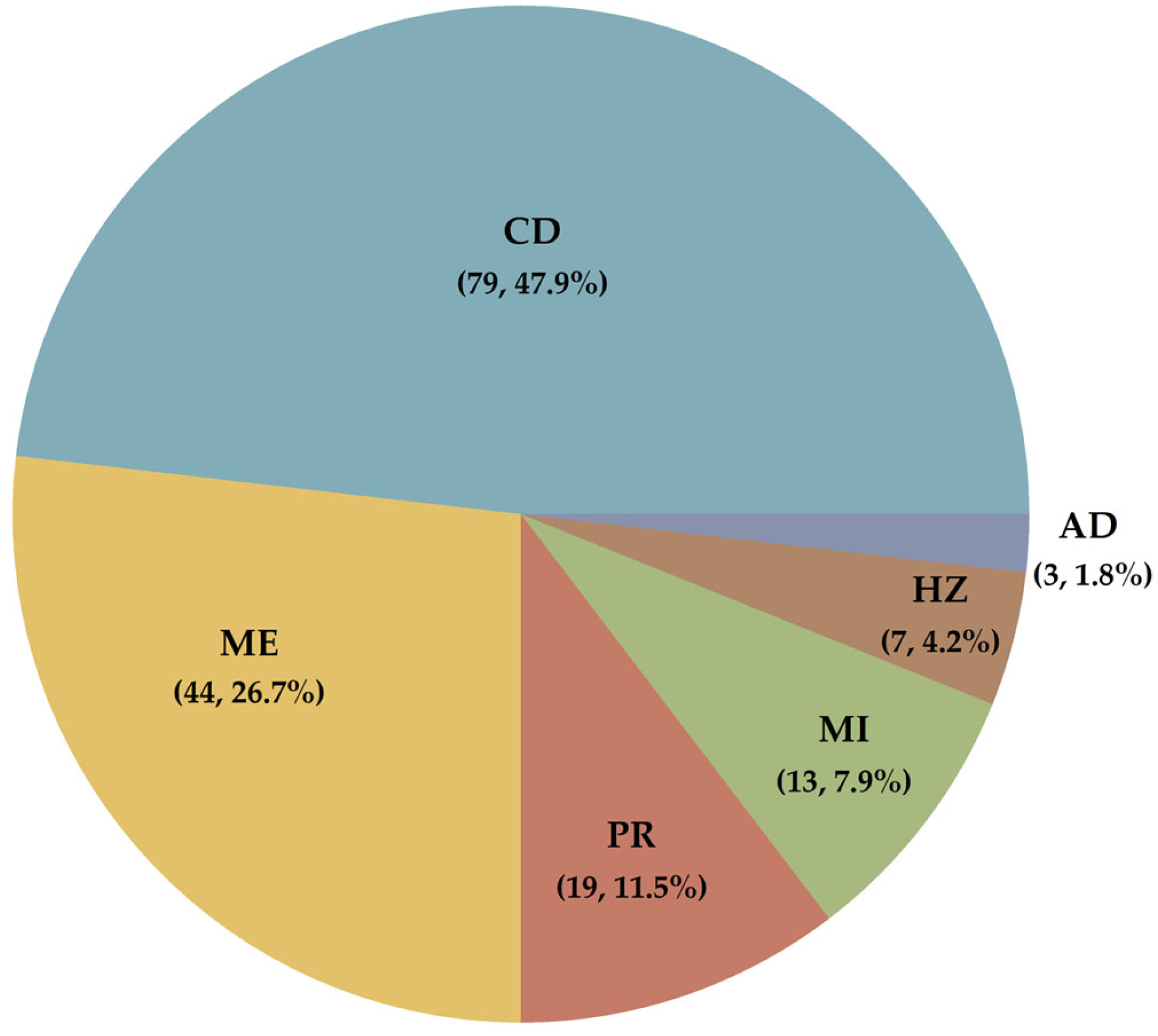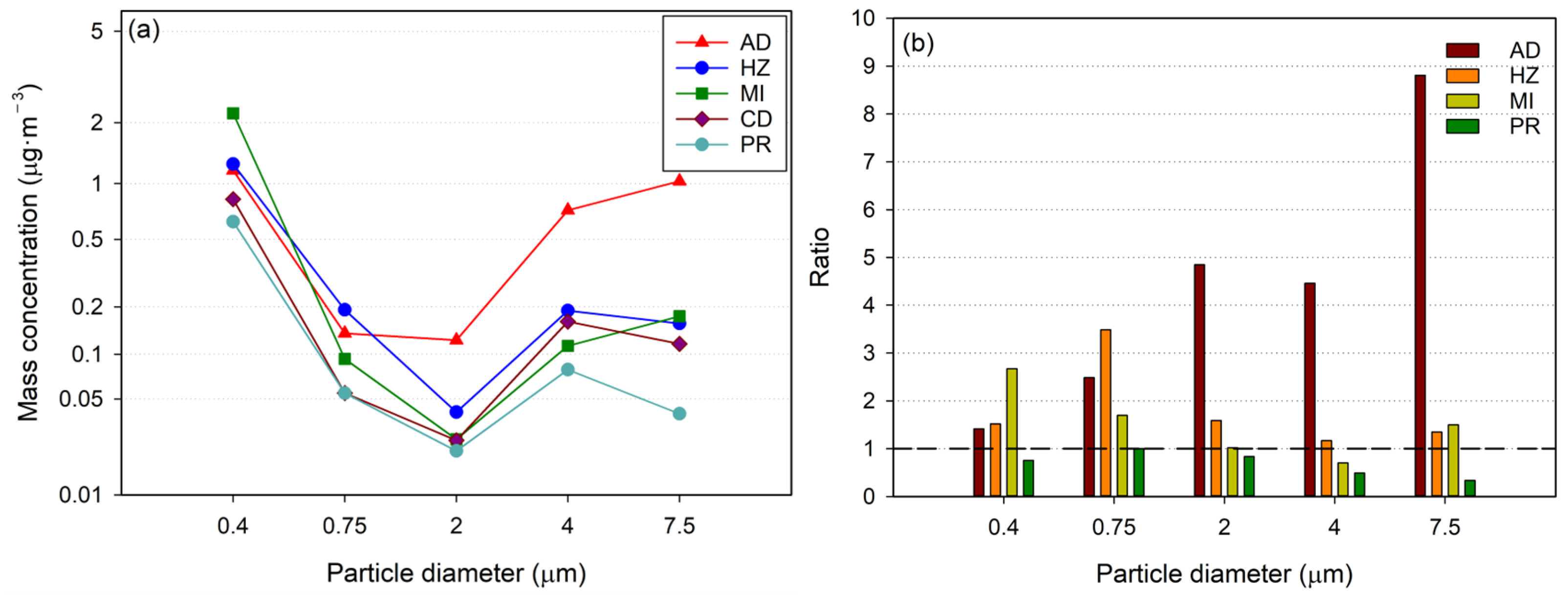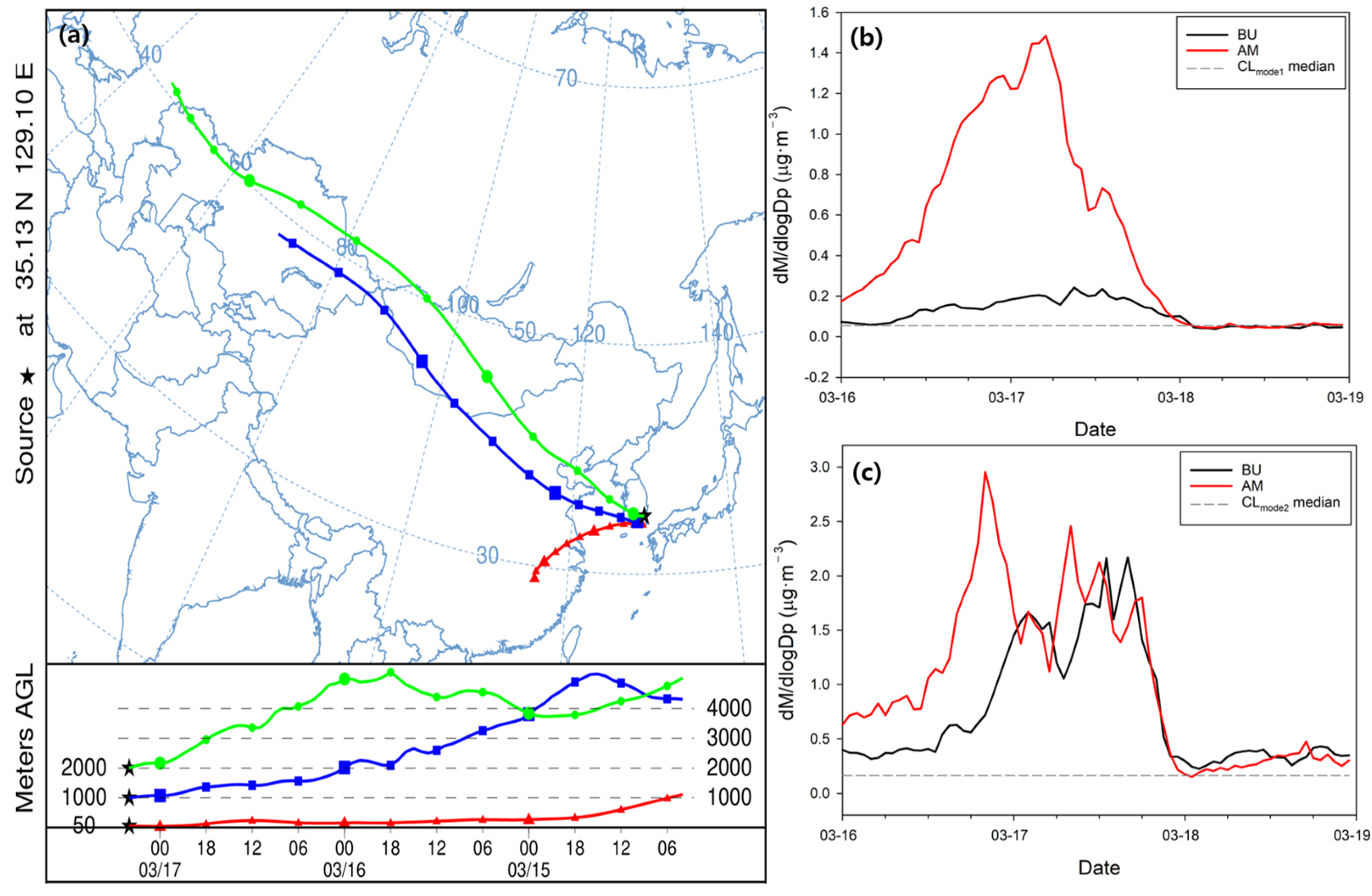Classification of High-Concentration Aerosol Phenomena Using Their Physical Properties in Busan, South Korea
Abstract
:1. Introduction
2. Materials and Methods
2.1. Intensive Observation for Aerosol Phenomena
2.2. Aerosol Size Distribution Function
2.3. Hybrid Single-Particle Lagrangian Integrated Trajectory
2.4. Classification of Meteorological Phenomena for Aerosol Physical Properties
- The PR cases were first classified by determining the presence or absence of precipitation during the day.
- If precipitation did not occur, the results wherein the Mode 2 concentrations of the AD and HZ were higher than those of the CD were used, and the cases were classified based on the median mass concentration (0.162 μg·m−3) in Mode 2 during CD.
- If the concentration was higher than the standard value, the capacity for long-distance transport was determined by comparing it with the aerosol size distribution data of Busan (LPC) and Anmyeondo (APS) and performing backward trajectory analysis using the HYSPLIT model at PKNU, whereby the LPC observation location was considered the starting point. When comparing the aerosol data between the two sites, the mass concentrations of both Modes 1 and 2 were compared. If it was not a long-distance transport phenomenon, we proceeded to Step 5. When the air masses undergo long-range transport through the Yellow Sea, the concentration of aerosol number may be influenced by sea salt particles. According to a previous study [34] on aerosol and sea salt particles in Busan, the same area analyzed in this study, the concentration of sea salt particles relative to the PM10 concentration was 3.86 μg/m3 when transported from the Shandong Peninsula, China, and 4.04 μg/m3 otherwise. In the case of aerosols transported over long distances to Busan, the authors judged that there was no large difference, and the influence near Busan was greater. Therefore, the difference according to the chemical properties of the particles did not exert a significant effect, and this study focused on the physical properties of the aerosols.
- If long-distance transport was confirmed, based on the AD cases with significantly higher mass concentration than HZ cases in Mode 2, the phenomenon was classified as a reference value (0.487 μg·m−3) based on the Q1 value of the mass concentration in Mode 2 of AD cases. If the concentration exceeded or was below this reference value, the phenomenon was classified as AD, or long-range transported haze (LH), respectively.
- If the mass concentration was lower than the standard value in Step 2, the cases were classified by setting the RH to 75% as the reference value. As MI and HZ events are visibility disturbances (from 1 to ≤ 10 km), these were classified based on the RH [35]. If RH was >75%, the phenomenon was considered an MI event.
- If RH was <75% in Step 5, the cases were classified based on the median mass concentration (0.055 μg·m−3) in Mode 1 during CD cases. If the concentration was lower than the standard value, the phenomenon was classified as CD.
- If the concentration exceeded the standard value in Step 6, the case was classified as a reference value (0.107 μg·m−3) based on the Q1 of the mass concentration in Mode 2 during HZ cases. If the concentration was lower than this reference value, the phenomenon was classified as CD.
- Finally, the events were divided into LH and urban haze (HZ) by determining the possibility of long-distance transport.
3. Results and Discussion
3.1. Aerosol Concentration Distributions
3.2. Derivation of Optimal Probability Density Function
3.3. Verification of Classification Accuracy
4. Conclusions
Author Contributions
Funding
Institutional Review Board Statement
Informed Consent Statement
Data Availability Statement
Acknowledgments
Conflicts of Interest
References
- Zhang, Q.; Streets, D.G.; Carmichael, G.R.; He, K.B.; Huo, H.; Kannari, A.; Klimont, Z.L.; Park, I.S.; Reddy, S.; Fu, J.S.; et al. Asian emissions in 2006 for the NASA INTEX-B mission. Atmos. Chem. Phys. 2009, 9, 5131–5153. [Google Scholar] [CrossRef] [Green Version]
- Choi, D.-R.; Koo, Y.-S.; Jo, J.-S.; Jang, Y.-K.; Lee, J.-B.; Park, H.-J. The Effect of Dust Emissions on PM10 Concentration in East Asia. J. Korean Soc. Atmos. Environ. 2016, 32, 32–45. [Google Scholar] [CrossRef] [Green Version]
- Tegen, I.; Hollrig, P.; Chin, M.; Fung, I.; Jacob, D.; Penner, J. Contribution of different aerosol species to the global aerosol extinction optical thickness: Estimates from model results. J. Geophys. Res. 1997, 102, 23895–23915. [Google Scholar] [CrossRef]
- Ginoux, P.; Prospero, J.M.; Torres, O.; Chin, M. Long-term simulation of global dust distribution with the GOCART model: Correlation with North Atlantic Oscillation. Environ. Model. Softw. 2004, 19, 113–128. [Google Scholar] [CrossRef]
- Kim, S.Y.; Lee, S.H. The analysis of the weather characteristics by source region of the Asian dust observed in South Korea. J. Korean Geogr. Soc. 2013, 48, 167–183. [Google Scholar]
- Chung, K.Y.; Park, S.U. Characteristic synoptic features associated with the transport of Asian dust to Korea, Korean. J. Atmos. Sci. 1995, 31, 45–63. [Google Scholar]
- Chun, Y.; Lim, J.; Choi, B. The features of aerosol in Seoul by Asian dust and haze during springtime from 1998 to 2002. J. Korean Meteorol. Soc. 2003, 39, 459–474. [Google Scholar]
- Kim, K.-M.; Kim, S.-W.; Choi, M.; Kim, M.; Kim, J.; Shin, I.; Kim, J.; Chung, C.-Y.; Yeo, H.; Kim, S.-W.; et al. Modeling Asian dust storms using WRF-Chem during the DRAGON-Asia field campaign in April 2012. J. Geophys. Res. Atmos. 2021, 126, e2021JD034793. [Google Scholar] [CrossRef]
- Kim, H.-S.; Cho, J.-H. Case studies of mass concentration variation in the Central-Southern Korean Peninsula caused by synoptic scale transport of dust storms. J. Korean Earth Sci. Soc. 2019, 40, 414–427. [Google Scholar] [CrossRef]
- Maki, T.; Furumoto, S.; Asahi, Y.; Lee, K.C.; Watanabe, K.; Aoki, K.; Murakami, M.; Tajiri, T.; Hasegawa, H.; Mashio, A.; et al. Long-range-transported bioaerosols captured in snow cover on Mount Tateyama, Japan: Impacts of Asian-dust events on airborne bacterial dynamics relating to ice-nucleation activities. Atmos. Chem. Phys. 2018, 18, 8155–8171. [Google Scholar] [CrossRef] [Green Version]
- Korea Meteorological Administration. Ground Meteorological Observation Guidelines; Korea Meteorological Administration: Seoul, Republic of Korea, 2016. [Google Scholar]
- Ye, X.; Song, Y.; Cai, X.; Zhang, H. Study on the synoptic flow patterns and boundary layer process of the severe haze events over the North China Plain in January 2013. Atmos. Environ. 2016, 124 Pt B, 129–145. [Google Scholar] [CrossRef]
- Shu, L.; Xie, M.; Gao, D.; Wang, T.; Fang, D.; Liu, Q.; Huang, A.; Peng, L. Regional severe particle pollution and its association with synoptic weather patterns in the Yangtze River Delta region, China. Atmos. Chem. Phys. 2017, 17, 12871–12891. [Google Scholar] [CrossRef] [Green Version]
- Tang, Y.; Han, S.; Yao, Q.; Cai, Z.; Qiu, Y.; Feng, J. Analysis of a Severe Regional Haze-fog-dust Episode over North China in Autumn by Using Multiple Observation Data. Aerosol Air Qual. Res. 2020, 20, 2211–2225. [Google Scholar] [CrossRef]
- Sheng, Z.; Che, H.; Chen, Q.; Xia, X.; Liu, D.; Wang, Z.; Zhao, H.; Gui, K.; Zheng, Y.; Sun, T.; et al. Aerosol vertical distribution and optical properties of different pollution events in Beijing in autumn 2017. Atmos. Res. 2019, 215, 193–207. [Google Scholar] [CrossRef]
- Kang, C.M.; Lee, H.S.; Kang, B.W.; Lee, S.K.; Sunwoo, Y. Chemical characteristics of acidic gas pollutants and PM2.5 species during hazy episodes in Seoul, South Korea. Atmos. Environ. 2004, 38, 4749–4760. [Google Scholar] [CrossRef]
- Jeon, B.-I. Characteristics of fine particle concentration and case during haze days in Busan. J. Environ. Sci. Int. 2017, 26, 751–765. [Google Scholar] [CrossRef]
- Lee, Y.G.; Cho, C.H. Characteristics of aerosol size distribution for a severe Asian dust event observed at Anmyeon, Korea in April 2006. J. Korean Meteorol. Soc. 2007, 43, 87–96. [Google Scholar]
- Jeong, G.Y.; Kim, J.Y.; Seo, J.; Kim, G.M.; Jin, H.C.; Chun, Y. Long-range transport of giant particles in Asian dust identified by physical, mineralogical, and meteorological analysis. Atmos. Chem. Phys. 2013, 14, 505–521. [Google Scholar] [CrossRef] [Green Version]
- Bae, G.N.; Kim, M.C.; Lim, D.Y.; Moon, K.C.; Baik, N.J. Characteristics of urban aerosol number size distribution in Seoul during the winter season of 2001. J. Korean Soc. Atmos. Environ. 2003, 19, 167–177. [Google Scholar]
- Park, S.H.; Jang, S.M.; Jung, W.S.; Jeong, J.H.; Lee, D.I. The fluctuation of marine aerosol number concentrations related with vertical winds. J. Korean Earth Sci. Soc. 2012, 33, 259–268. [Google Scholar] [CrossRef] [Green Version]
- Song, J.-M.; Bu, J.-O.; Yang, S.-H.; Lee, J.-Y.; Kim, W.-H.; Kang, C.-H. Influences of Asian dust, haze, and mist events on chemical compositions of fine particulate matters at Gosan site, Jeju Island in 2014. J. Korean Soc. Atmos. Environ. 2016, 32, 67–81. [Google Scholar] [CrossRef] [Green Version]
- Park, S.-U.; Kim, J.-W. Aerosol size distributions observed at the Seoul National University campus in Korea during the Asian dust and non-Asian dust periods. Atmos. Environ. 2006, 40, 1722–1730. [Google Scholar] [CrossRef]
- Hyeon, D.-R.; Song, J.-M.; Kim, K.-J.; Kim, W.-H.; Kang, C.-H.; Ko, H.-J. Compositions of haze aerosols and their variation by inflow pathway of air mass at Gosan site in Jeju Island during 2012–2013. Anal. Sci. Technol. 2014, 27, 213–222. [Google Scholar] [CrossRef] [Green Version]
- Jung, J.; Kim, Y.J.; Lee, K.Y.; Cayetano, M.G.; Batmunkh, T.; Koo, J.-H.; Kim, J. Spectral optical properties of long-range transport Asian dust and pollution aerosols over Northeast Asia in 2007 and 2008. Atmos. Chem. Phys. 2010, 10, 5391–5408. [Google Scholar] [CrossRef] [Green Version]
- Shi, H.; Lee, S.-S.; Chun, H.-W.; Song, H.-J.; Noh, Y.-C.; Sohn, B.-J. Optical properties of aerosols related to haze events over Seoul inferred from skyradiometer and satellite-borne measurements. Atmosphere 2016, 26, 289–299. [Google Scholar] [CrossRef]
- Choo, G.-H.; Lee, K.; Seo, J.; Kim, S.-Y.; Lee, D.-W.; Shin, H.-J. Optical and chemical properties of long-range transported aerosols using satellite and ground-based observations over seoul, South Korea. Atmos. Environ. 2021, 246, 118024. [Google Scholar] [CrossRef]
- Sokolov, A.; Dmitriev, E.; Gengembre, C.; Delbarre, H. Automated Classification of Regional Meteorological Events in a Coastal Area Using In Situ Measurements. J. Atmos. Ocean. Technol. 2020, 37, 723–739. [Google Scholar] [CrossRef]
- Lee, Y.; Cho, C.; Kim, M. Developing a Method for Detecting the Asian dust event Among High PM10 events Using aerodynamic particle Sizer (APS). Atmosphere 2008, 18, 25–32. [Google Scholar]
- Seinfeld, J.H.; Pandis, S.N. Atmospheric Chemistry and Physics; John Wiley & Sons: New York, NY, USA, 1998. [Google Scholar]
- Kim, J.-E.; Lee, H.-Y. Aerosol density determined using micro-orifice uniform deposit impactor and aerosol dust monitors data at Seoul. J. Korean Soc. Atmos. Environ. 2010, 26, 298–304. [Google Scholar] [CrossRef] [Green Version]
- Kim, M.-J.; Kim, Y.J.; Sohn, E.-H.; Kim, K.-L.; Ahn, M.-H. The study on the Quantitative Dust Index Using geostationary Satellite. Atmosphere 2008, 18, 267–277. [Google Scholar]
- Stein, A.F.; Draxler, R.R.; Rolph, G.D.; Stunder, B.J.B.; Cohen, M.D.; Ngan, F. NOAA’s HYSPLIT atmospheric transport and dispersion modeling system. Bull. Am. Meteorol. Soc. 2015, 96, 2059–2077. [Google Scholar] [CrossRef]
- Jo, H.-Y.; Kim, C.-H. Characteristics of East Asian Synoptic Meteorological Conditions in Association with Haze phenomena. Atmosphere 2010, 20, 161–172. [Google Scholar]
- Jeon, B.-I. Characteristics of Metallic and Ionic Elements Concentration in PM10 at Guducsan in Busan. J. Environ. Sci. 2016, 25, 715–726. [Google Scholar] [CrossRef] [Green Version]
- West, S.G.; Finch, J.F.; Curran, P.J. Structural equation models with nonnormal variables: Problems and remedies. In Structural Equation Modeling: Concepts, Issues, and Applications; Hoyle, R.H., Ed.; Sage Publications, Inc.: Thousand Oaks, CA, USA, 1995; pp. 56–75. [Google Scholar]
- Whitby, K.T. The physical characteristics of sulfur aerosols. Atmos. Environ. 1978, 12, 135–159. [Google Scholar] [CrossRef]











| Item | Contents |
|---|---|
| Light collection | Wide-angle light collection by the ellipsoidal mirror |
| Light source | Laser diode |
| Particle diameter | <10.0 μm |
| Size channels | 0.3, 0.5, 1.0, 3.0, 5.0, and 10.0 μm |
| Sample flow rate | 28.3 L·min−1 |
| Power supply | Ni-Cd Battery with AC adaptor (standard) dry cell battery/U2X9 (optional) |
| Case | Particle Size | Mean | Standard Deviation | 25 Percentile (Q1) | Median (Q2) | 75 Percentile (Q3) | IQR | MAD |
|---|---|---|---|---|---|---|---|---|
| AD | 0.3–0.5 | 1.1755 | 0.7010 | 0.5318 | 1.1688 | 1.6243 | 1.0925 | 0.6083 |
| 0.5–1.0 | 0.4099 | 0.8050 | 0.0959 | 0.1366 | 0.2164 | 0.1205 | 0.0439 | |
| 1.0–3.0 | 0.3858 | 0.9789 | 0.0809 | 0.1235 | 0.2150 | 0.1341 | 0.0458 | |
| 3.0–5.0 | 1.7291 | 3.6500 | 0.4868 | 0.7222 | 1.3265 | 0.8397 | 0.3217 | |
| 5.0–10 | 2.2100 | 5.1697 | 0.0855 | 1.0283 | 1.9761 | 1.8906 | 0.9436 | |
| HZ | 0.3–0.5 | 1.5776 | 0.9411 | 0.9442 | 1.2561 | 2.4267 | 1.4825 | 0.5105 |
| 0.5–1.0 | 0.1894 | 0.1098 | 0.0791 | 0.1915 | 0.2808 | 0.2017 | 0.1061 | |
| 1.0–3.0 | 0.0494 | 0.0271 | 0.0272 | 0.0405 | 0.0646 | 0.0374 | 0.0185 | |
| 3.0–5.0 | 0.3000 | 0.3056 | 0.1072 | 0.1893 | 0.3524 | 0.2452 | 0.1131 | |
| 5.0–10 | 0.3171 | 0.3680 | 0.0558 | 0.1575 | 0.4783 | 0.4225 | 0.1179 | |
| MI | 0.3–0.5 | 2.2309 | 1.2751 | 1.0858 | 2.2125 | 3.0921 | 2.0063 | 0.9497 |
| 0.5–1.0 | 0.1141 | 0.0818 | 0.0639 | 0.0932 | 0.1180 | 0.0541 | 0.0283 | |
| 1.0–3.0 | 0.0314 | 0.0265 | 0.0088 | 0.0259 | 0.0460 | 0.0372 | 0.0177 | |
| 3.0–5.0 | 0.2475 | 0.4472 | 0.0685 | 0.1134 | 0.2332 | 0.1647 | 0.0614 | |
| 5.0–10 | 0.2828 | 0.3416 | 0.0585 | 0.1748 | 0.3382 | 0.2797 | 0.1224 | |
| PR | 0.3–0.5 | 1.1178 | 1.1702 | 0.2327 | 0.6258 | 1.5017 | 1.2691 | 0.5244 |
| 0.5–1.0 | 0.0627 | 0.0388 | 0.0354 | 0.0549 | 0.0790 | 0.0436 | 0.0213 | |
| 1.0–3.0 | 0.0282 | 0.0303 | 0.0119 | 0.0213 | 0.0343 | 0.0224 | 0.0123 | |
| 3.0–5.0 | 0.1779 | 0.3571 | 0.0355 | 0.0791 | 0.1843 | 0.1488 | 0.0590 | |
| 5.0–10 | 0.2441 | 0.7849 | 0.0167 | 0.0395 | 0.1973 | 0.1806 | 0.0349 | |
| CD | 0.3–0.5 | 1.0887 | 0.9387 | 0.3165 | 0.8278 | 1.5963 | 1.2798 | 0.5654 |
| 0.5–1.0 | 0.0822 | 0.0674 | 0.0368 | 0.0550 | 0.1054 | 0.0686 | 0.0232 | |
| 1.0–3.0 | 0.0333 | 0.0292 | 0.0142 | 0.0255 | 0.0424 | 0.0282 | 0.0136 | |
| 3.0–5.0 | 0.3264 | 0.4135 | 0.0939 | 0.1620 | 0.3870 | 0.2931 | 0.0999 | |
| 5.0–10 | 0.3684 | 0.5944 | 0.0402 | 0.1168 | 0.4963 | 0.4561 | 0.0967 |
| Logarithmic Transformation | |||||||||||
|---|---|---|---|---|---|---|---|---|---|---|---|
| Before | After | ||||||||||
| Variables | Cases | 0.3–0.5 | 0.5–1.0 | 1.0–3.0 | 3.0–5.0 | 5.0–10 | 0.3–0.5 | 0.5–1.0 | 1.0–3.0 | 3.0–5.0 | 5.0–10 |
| Skewness | AD | 0.51 | 3.97 | 4.79 | 4.70 | 4.63 | −0.63 | 1.43 | 1.84 | 1.63 | −0.09 |
| HZ | 0.62 | 0.26 | 0.68 | 2.16 | 2.00 | −0.52 | −0.25 | 0.06 | 0.18 | −0.08 | |
| MI | 0.28 | 1.73 | 1.51 | 4.62 | 2.30 | −0.74 | −0.66 | −0.76 | −0.64 | −0.49 | |
| PR | 1.44 | 1.90 | 4.26 | 6.18 | 7.74 | −0.36 | −1.28 | −0.52 | −0.46 | 0.27 | |
| CD | 1.17 | 2.03 | 1.84 | 0.94 | 1.78 | −0.09 | 0.57 | −0.42 | −1.58 | −1.17 | |
| Kurtosis | AD | −0.22 | 16.78 | 23.26 | 22.39 | 21.84 | −0.66 | 1.38 | 3.59 | 3.43 | −0.76 |
| HZ | −0.66 | −1.23 | −0.80 | 4.87 | 4.36 | −0.38 | −1.49 | −1.21 | −0.46 | −0.90 | |
| MI | −0.77 | 2.69 | 3.74 | 24.91 | 5.90 | −0.52 | 2.22 | 0.48 | 1.84 | −0.02 | |
| PR | 1.47 | 8.00 | 26.57 | 47.76 | 68.41 | 0.01 | 6.86 | 0.43 | 1.08 | −0.09 | |
| CD | 1.02 | 4.35 | 3.31 | 0.68 | 3.81 | −0.86 | −0.08 | 0.95 | 3.23 | 2.27 | |
| Case | Parameter | Nt (μg·m−3) | d (μm) | σ (μm) |
|---|---|---|---|---|
| Asian Dust (AD) | Mode 1 | 1.76 | 0.42 | 1.42 |
| Mode 2 | 4.03 | 5.10 | 1.52 | |
| Haze (HZ) | Mode 1 | 3.00 | 0.38 | 1.36 |
| Mode 2 | 0.53 | 5.14 | 1.49 | |
| Mist (MI) | Mode 1 | 3.79 | 0.40 | 1.28 |
| Mode 2 | 0.36 | 5.28 | 1.47 | |
| Precipitation (PR) | Mode 1 | 2.55 | 0.35 | 1.34 |
| Mode 2 | 0.36 | 5.49 | 1.51 | |
| Clear days (CD) | Mode 1 | 2.14 | 0.36 | 1.35 |
| Mode 2 | 0.62 | 5.24 | 1.46 |
| Date | Algorithm | KMA | Verification | Mode 1 (μg·m−3) | Mode (μg·m−3) |
|---|---|---|---|---|---|
| 17 March 2009 | AD | AD | O | 0.191 | 1.540 |
| 12 April 2009 | LH | HZ | O | 0.195 | 0.237 |
| 2 April 2011 | UH | HZ | O | 0.068 | 0.172 |
| 12 March 2010 | MI | MI | O | 0.246 | 0.087 |
| 13 April 2010 | MI | MI | O | 0.072 | 0.313 |
| 19 May 2011 | MI | MI | O | 0.047 | 0.094 |
| 16 April 2009 | PR | PR | O | 0.034 | 0.127 |
| 15 April 2010 | PR | PR | O | 0.037 | 0.200 |
| 23 May 2011 | PR | PR | O | 0.029 | 0.007 |
Disclaimer/Publisher’s Note: The statements, opinions and data contained in all publications are solely those of the individual author(s) and contributor(s) and not of MDPI and/or the editor(s). MDPI and/or the editor(s) disclaim responsibility for any injury to people or property resulting from any ideas, methods, instructions or products referred to in the content. |
© 2022 by the authors. Licensee MDPI, Basel, Switzerland. This article is an open access article distributed under the terms and conditions of the Creative Commons Attribution (CC BY) license (https://creativecommons.org/licenses/by/4.0/).
Share and Cite
Kang, D.-D.; Goo, T.-Y.; Lee, D.-I. Classification of High-Concentration Aerosol Phenomena Using Their Physical Properties in Busan, South Korea. Appl. Sci. 2023, 13, 355. https://doi.org/10.3390/app13010355
Kang D-D, Goo T-Y, Lee D-I. Classification of High-Concentration Aerosol Phenomena Using Their Physical Properties in Busan, South Korea. Applied Sciences. 2023; 13(1):355. https://doi.org/10.3390/app13010355
Chicago/Turabian StyleKang, Deok-Du, Tae-Young Goo, and Dong-In Lee. 2023. "Classification of High-Concentration Aerosol Phenomena Using Their Physical Properties in Busan, South Korea" Applied Sciences 13, no. 1: 355. https://doi.org/10.3390/app13010355
APA StyleKang, D.-D., Goo, T.-Y., & Lee, D.-I. (2023). Classification of High-Concentration Aerosol Phenomena Using Their Physical Properties in Busan, South Korea. Applied Sciences, 13(1), 355. https://doi.org/10.3390/app13010355






